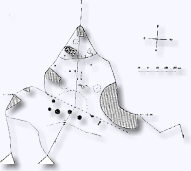Metsamor 2: Museum | Ground Floor | Upstairs | Lower Level | Gold Rooms
Metsamor 3: Excavation | Temple | Observatory | Getting Back
download Arial AM font
The Museum
The Museum of History and Archeology at Metsamor was opened in 1968.
It is the repository of more than 22,000 items, almost all uncovered at
the site.
Overview: The museum is laid out on three levels. Our self-tour walks you through the museum in the order tour guides follow.
Ground
Floor
The ground floor shows the chronological development of the site from
the Neolithic through the Middle Ages, and includes artifacts and materials
discovered at each layer of the excavation, including examples of the
metal working process used at Metsamor. One section is devoted to
the observatory and explains the astronomical significance of the site.
In the entry lobby are two maps, one showing the current excavation site (citadel and central city), the other the extent of the Ancestral Armenian culture in the Armenian plateau during the Early, Middle and Late Bronze Ages.
Take the steps to the ground floor, and turn to your left.
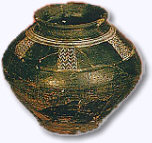 1st
Gallery, Ground Floor
1st
Gallery, Ground Floor
1. The first display is a strata-map, showing the
various layers of the excavation, and samples of
artifacts (pottery) found in
each layer.
-
A. Early Bronze Age: A feature of this period are black lacquered
ceramic, the earliest of its kind discovered in Asia Minor. The
technique for creating the glaze required a sophisticated knowledge of
both firing technique and minerals to create the even glaze.
B. Middle Bronze Age: Reddish ceramic with detailed designs showing wheat and spiral designs evolved along with a glazing process over the black pottery. It is in this period that a hierarchic social structure evolved, along with a preoccupation with elaborate ornamented design. The pottery and design details resemble those found on Mycanaean ceramics discovered at Santorini and elsewhere, but are older.
C. Late Bronze Age: The designs and patterns are closer to those found throughout Asia Minor. You could very well be looking at pottery from Greece, Egypt and Cyprus, which incorporated designs like that used at Metsamor.
2. The second display holds samples of weapons and jewelry from the Early and Middle Bronze Age.
3. In this display you can see some early examples
of chinaware and pottery from the Late Bronze
Age. China is an extremely
difficult process to master, and though the pieces you see are not as
delicate or refined as Ming
Dynasty masterpieces, they are amazing engineering samples
nonetheless, predating the
Ming by 3000 years.
4. Jewelry display.
5. Jewelry display.
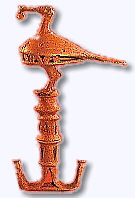 6.
In the large display opposite cases 2-5, there is a large display showing
pottery jugs and vases, and other implements found in the excavation.
Most are from the Late bronze to early iron age. The jugs and pottery
held wine, wheat, seeds and oil, and include serving and storage vessels.
6.
In the large display opposite cases 2-5, there is a large display showing
pottery jugs and vases, and other implements found in the excavation.
Most are from the Late bronze to early iron age. The jugs and pottery
held wine, wheat, seeds and oil, and include serving and storage vessels.
7. In the same display hangs an Incense burner with lion head hanging in the center of the display. It has a bronze chain and bells, and was used in the temple (Late Bronze Age). The lion head is an often-used feature in royal and worship designs, and there were lions and tigers that inhabited this area at that time. There are still a few leopards inhabiting Armenian wilderness areas, but the lion was the preferred symbol.
The Name
The term Metsamor is a more recent name. The inhabitants of the
city did not use a writing system as we do. They used a pictograph
system of drawings that represented ideas and events, but did not spell
out names as we do. We do not know what these people called themselves,
but since Ancestral Armenia was a bridge between Asia and Europe we do
know what other cultures at the time called the people living in this
area. The Persians called them the “Ermani”, the Babylonians “Arata”,
the Assyrians “Nairi” . Later the Indo-European name “Ararat” and
“Armeni” become predominant names, though “Hai” was used by the Hittites.
Our guide suggested that though “Hai” and “Armen” were both names for
the same people, the word “Hai” is in fact an older name, as etymologists
believe it originated in the Ararat and Geghama mountains and migrated
with Ancestral Armenians into Anatolia and Asia Minor.
8. At the end of the first exhibition hall is
a display featuring the observatory uncovered at
Metsamor (4th-3rd millennium
BC) and it use in the study of the cosmos.
The development of astronomical study at Metsamor grew from a need by the inhabitants to orient themselves in space and time. They had a specific need to understand where the spirit went in the afterlife, to understand the conception of time, and to fix themselves in space. This is a far cry from earlier people’s who stared at the heavens and simply wondered at it all: this was a sacred study, so to speak, to actually fix the culture in the heavens, and to predict its influence on their destiny.
The means of orienting oneself are the beginning steps of social group development, and are usually very simple. For the people at Metsamor, it was typical to orient themselves, their culture, and their place in time and space by East and South.
Inner illustrations:
A. In the picture on the wall, you will see both a schematic of the observatory, and a series of illustrations showing how they charted the stars and created the first known calendar of time, a division of the year into twelve segments.
B. The small lines on the wheel illustration show 3 observation points on the actual wheel inscription uncovered at the observatory. Near these points were found star symbols (representations of Aries, Leo and Taurus), and a compass.
C. Explorations of the first observatory site show that by ca. 3000 BC it was possible to observe the brightest star in the Northern sky, Sirius. Sirius lies in the constellation Canis Major, and is very close to earth, only about about 8.6 light years away.
2nd Gallery, Ground Floor
9. The displays in this gallery focus on the Early
Iron Age, when the culture at Metsamor advanced
to a high level. The
first display shows both implements used to smelt refined metals,
and
examples of finished products.
Jewelry made of tin and Silver are included. The inhabitants of
Metsamor were able to extract
gold from other ores, and there is even evidence they fabricated
synthetic gold from other substances.
10. The next display focuses on the Urartian period
of development, and you will notice in the
farthest case several stone
carvings that emulate the male genitalia (is that clinical enough for
ya?). The Urartians believed
that infertile women who worshipped and touched (one can only
wonder how) these phallus idols
would become fruitful and multiply.
11. There is a very black stone, called kisher, (“night”
stone, also obsidian) in the display which was
used for its medical properties.
Upstairs
The second floor is divided into two sections. The first displays
materials in trades common at Metsamor: stone, jewelry, textiles and leather,
carpet weaving, ceramics, plus the glazed bluish-green decorative tiles
that ornamented the palace and temple halls. The second section is devoted
to the temple excavation and religious worship. Included are idols,
phallus sculptures, fire hearths, pintader seals for stamping scared bread
loaves and amulets.
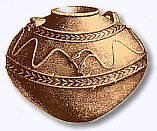
12. Ringing the stairwell and along the walls
of the upstairs gallery are large wine and oil pots, jugs and vases, all
found from the Early to Middle Bronze Age (5000-3000 BC). Note the
design of the snakes and mountain rams on the surfaces. The snakes
were considered life-giving creatures, and were worshipped as gods.
The rams were at first thought to be god images, but are now known to
also represent the constellation Aries in the horoscope, a power associated
with the home, the hearth, and sustenance.
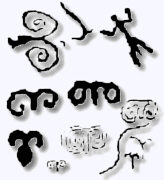 The
Greek constellation and word for Aries did not arise until the 2nd millennium
BC. If you have read the history of Armenia so far, remember
the importance of the first two letters “AR”. Etymologists believe
the word Aries is not in fact Greek, but actually came from this area.
The
Greek constellation and word for Aries did not arise until the 2nd millennium
BC. If you have read the history of Armenia so far, remember
the importance of the first two letters “AR”. Etymologists believe
the word Aries is not in fact Greek, but actually came from this area.
13. If you turn left as you enter the gallery from the stairwell, you will see a large bronze object in the center of the wall. This is an enlargement of one of the prize possessions of the museum, a Babylonian frog weight carved from agate and onyx. On the surface of the frog, in Babylonian cuneiform is written “I, Burna Burarishi, am a son of King Buran Burarishi”. The weight of the original (in the basement vault) is 8 grams, 62 decigrams. It was used as jewelry, a measurement tool and a standard of weight. Found in one of the royal tombs around the neck of a woman, it is the only example of its kind in the world.
14. Before you reach the back wall of the gallery,
notice a portable fire hearth, divided into thirds.
The fire hearths were at first
thought to be portable stoves, and the History Museum in
Yerevan still ascribes them
to that purpose. It is now thought that they were also temple
worship hearths, where rare
myrrh, frankincense and other incense were burned in worship to
the local deities. Some
of the incense discovered at Metsamor has its origins in India and
China, verifying early use
of the Northern trade routes between Asia and Asia Minor.
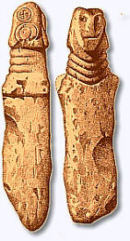
15. In the right display case on the back wall are
temple worship artifacts uncovered at Metsamor (Early to Late
Bronze Age). Among these are several small carved stones, including
one with the design of a swastika on one side and another with the head
of a dog carved on the back side (th example at left is carved with a
human deity). The swastika carving is one of the oldest sacred symbols
in the world, and cave drawings in the Geghama Mountains dating back to
the Neolithic times (7000 BC) include them. It is unfortunate the
Nazis corrupted their meaning in our times, as the swastika is a strong
link between the Indo-Europeans and the indigenous cultures of ancient
times. In Armenia examples of swastikas include swirling arms to
both the right and left. Not a crooked cross, as some people call
them, they are actually one of the first drawings of movement, showing
a swirling power burning in the heavens. The swastika was the primary
symbol assigned to the gods for several thousand years.
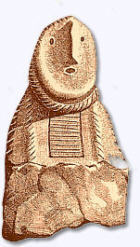 16.
Included in the temple display is an illustration of the temple interior
from the late Bronze Age. The worship of the bull was included in
the deities, but it had a strong and negative position in the Metsamor
pantheon: it was also used for placing curses. It is not until
later, during the Urartian period, that it became a symbol of strength
and fortitude.
16.
Included in the temple display is an illustration of the temple interior
from the late Bronze Age. The worship of the bull was included in
the deities, but it had a strong and negative position in the Metsamor
pantheon: it was also used for placing curses. It is not until
later, during the Urartian period, that it became a symbol of strength
and fortitude.
17. Behind the central back wall, standing by the stairwell, is a large stone idol (11th-9th BC). Yup, it’s a phallus.
18. The other half of the gallery is devoted to tools and implements used in the various trades in Metsamor. The last display hold examples of the types of stones and minerals mined and used at the foundry.
Lower Level
The lower level holds the most valuable archeological finds in the museum:
a funerary crypt from the Urartu period and a collection of gold, silver,
semi-precious stones, amber and paste jewelry, as well as other examples
discovered at burial sites in the excavation.
19. Just at the bottom of the stairs is a replication
of an Urartu burial site. It positions the artifacts
and skeletons exactly as they
were found during excavation. The skeleton lying on its side is
a
wealthy slaveholder, the heads
along the side his slaves. The most important part of the body
was understood to be the head,
and Urartian burial rites included cutting the heads from the
bodies of slaves when their
master died, preserving their “identity” so the deceased master could
recognize them when he went
to the other world.
![]() TOP
TOP
The Gold Rooms
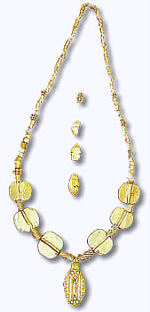 There
are several cases in two rooms in the gold vault. The craftsmanship
and detail of the work was intricate and sometimes minuscule: take care
to examine the pieces, and then imagine people creating such fine work
more than 4000 years ago.
There
are several cases in two rooms in the gold vault. The craftsmanship
and detail of the work was intricate and sometimes minuscule: take care
to examine the pieces, and then imagine people creating such fine work
more than 4000 years ago.
1st Room
1st case: Gold jewelry pieces discovered in mausoleums, featuring a gold necklace with intricate design, 3rd-2nd millennium BC.
2nd case: Hollow cylinder made from sardonik (a red-veined onyx), 4th millennium BC.
3rd case: actual frog weight carved from agate and onyx, 4th-3rd millennium BC.
4th case: jewelry made from gold and carnelian (a semi-precious quartz gem). Gold medallions imbedded with cruciform design, 2nd millennium BC.
5th case: royal seal made from carnelian, gold clasps, 3rd millennium BC.
6th case: gold jewelry, including hairpin and medallion, 3rd-2nd millennium BC.
1st case: amber necklaces, 4th-3rd millennium BC.
2nd case: “matsuk” animal heads with eyes made from lapis lazuli, 4th millennium BC. Lapis Lazuli was considered more valuable than gold in the ancient world, and was prized for its medicinal and cosmetic, as well as artistic value.
3rd case: amber jewelry and small agate stone called “achki ulunk” (eye beads), 4th-3rd millennium BC. These are considered to be protective eyes warding off evil, and are still popular amulets worn around the necks of newborns in Armenia.
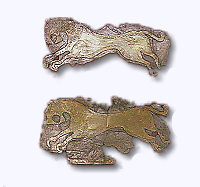 4th
case: two belt decoration pieces in the shape of lions, made from bronze
with silver overlay. Swastika detail on the hindquarters of the
lions. The overlay process was probably created in the Armenian
plateau, as this is one of the earliest examples found in Asia minor
(3rd millennium BC)
4th
case: two belt decoration pieces in the shape of lions, made from bronze
with silver overlay. Swastika detail on the hindquarters of the
lions. The overlay process was probably created in the Armenian
plateau, as this is one of the earliest examples found in Asia minor
(3rd millennium BC)
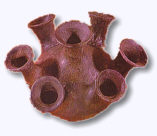 Store
Room
Store
Room
IF you’re very lucky, the guides may allow you into the storeroom, where
20,000 additional artifacts are kept. One of the most rare and beautiful
of them is kept there. It is a reddish brown ceramic lamp with seven
fluted openings on the top: the openings represent the sun, moon and the
five known constellations at that time.
